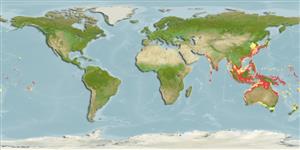>
Syngnathiformes (Pipefishes and seahorses) >
Syngnathidae (Pipefishes and seahorses) > Syngnathinae
Etymology: Hippocampus: Greek, ippos = horse + Greek,kampe = curvature (Ref. 45335).
Issue
Junior synonyms Hippocampus dahli Ogilby, 1908 (more studies needed) and H. planifrons Peters, 1877 are considered valid species according to Lourie et al., 2016 (Ref. 115213).
Environment: milieu / climate zone / depth range / distribution range
Sinh thái học
Biển Cùng sống ở rạn san hô; không di cư; Mức độ sâu 0 - 100 m (Ref. 52034), usually ? - 20 m (Ref. 30915). Tropical; 42°N - 42°S, 65°E - 132°W
Indo-West Pacific: India to Tahiti; north to Japan, south to Indonesia.
Length at first maturity / Bộ gần gũi / Khối lượng (Trọng lượng) / Age
Maturity: Lm 14.0 range ? - ? cm
Max length : 22.0 cm TL con đực/không giới tính; (Ref. 48635)
Các tia vây lưng cứng (tổng cộng): 0; Các vây lưng mềm (tổng cộng): 18-22; Tia cứng vây hậu môn 0; Tia mềm vây hậu môn: 4.
Inhabits gravel or sand bottoms around shallow reefs (Ref. 559); muddy estuaries and near mangroves, tolerating brackish waters (Ref. 48635). Occur singly or in pairs (Ref. 128523). Ovoviviparous (Ref. 205). The male carries the eggs in a brood pouch which is found under the tail (Ref. 205).
Male carries the eggs in a brood pouch (Ref. 205).
Lourie, S.A., R.A. Pollom and S.J. Foster, 2016. A global revision of the seahorses Hippocampus Rafinesque 1810 (Actinopterygii: Syngnathiformes): taxonomy and biogeography with recommendations for further research. Zootaxa 4146(1):1-66. (Ref. 115213)
IUCN Red List Status (Ref. 130435)
Threat to humans
Harmless
Human uses
Nuôi trồng thủy sản: Tính thương mại
Thêm thông tin
Các tài liệu tham khảoNuôi trồng thủy sảnTổng quan nuôi trồng thủy sảnCác giốngDi truyềnElectrophoresesDi sảnCác bệnhChế biếnNutrientsMass conversion
Các công cụ
Special reports
Download XML
Các nguồn internet
Estimates based on models
Preferred temperature (Ref.
123201): 24.2 - 29.1, mean 28.3 °C (based on 622 cells).
Phylogenetic diversity index (Ref.
82804): PD
50 = 0.5000 [Uniqueness, from 0.5 = low to 2.0 = high].
Bayesian length-weight: a=0.00447 (0.00177 - 0.01127), b=3.00 (2.78 - 3.22), in cm total length, based on LWR estimates for this (Sub)family-body shape (Ref.
93245).
Mức dinh dưỡng (Ref.
69278): 3.8 ±0.50 se; based on food items.
Generation time: 2.2 ( na - na) years. Estimated as median ln(3)/K based on 1
growth studies.
Thích nghi nhanh (Ref.
120179): Chiêù cao, thời gian nhân đôi của chủng quần tối thiểu là dưới 15 tháng (tm=0.5-1).
Fishing Vulnerability (Ref.
59153): Low vulnerability (12 of 100).
Nutrients (Ref.
124155): Calcium = 85.9 [49.5, 172.7] mg/100g; Iron = 0.776 [0.449, 1.459] mg/100g; Protein = 18.2 [17.0, 19.3] %; Omega3 = 0.131 [0.076, 0.242] g/100g; Selenium = 45.8 [23.7, 101.7] μg/100g; VitaminA = 65.2 [22.2, 185.9] μg/100g; Zinc = 1.35 [0.92, 1.94] mg/100g (wet weight);
